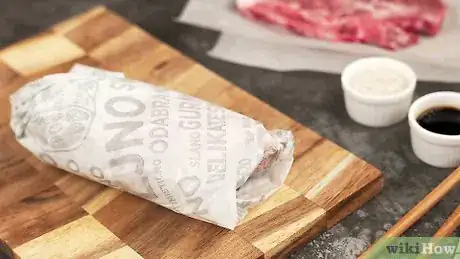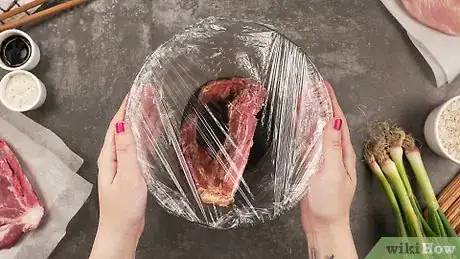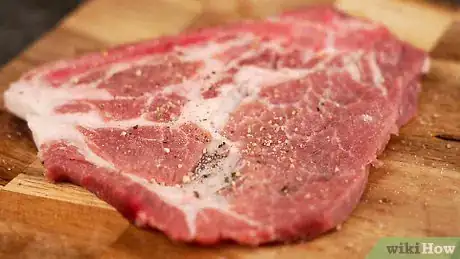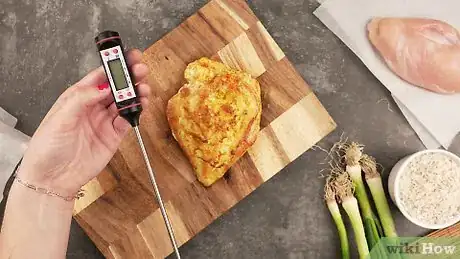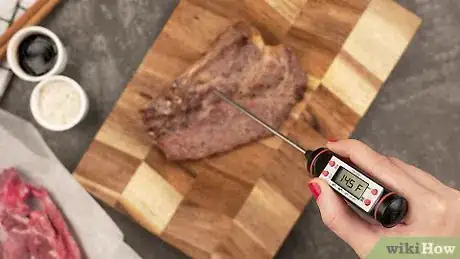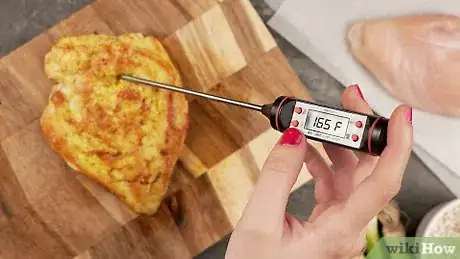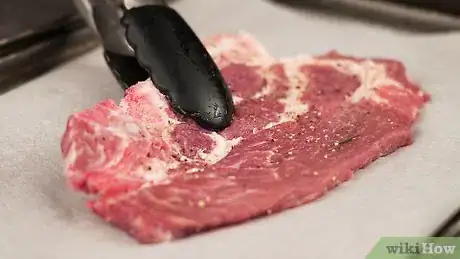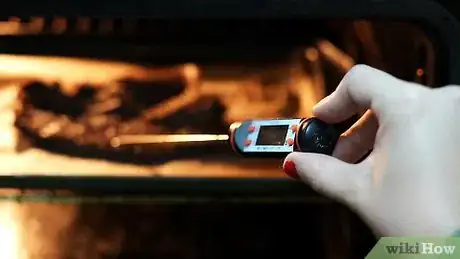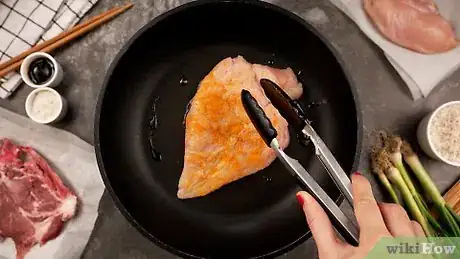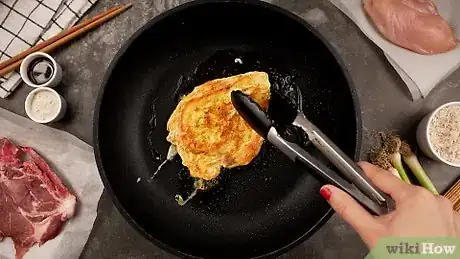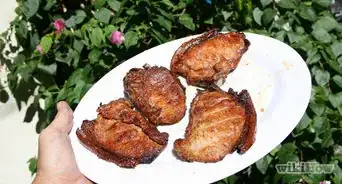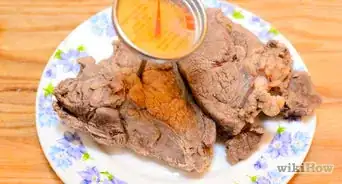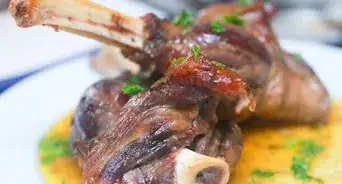This article was co-authored by Alex Hong and by wikiHow staff writer, Hunter Rising. Alex Hong is the Executive Chef and Co-Owner of Sorrel, a New American restaurant in San Francisco. He has been working in restaurants for over ten years. Alex is a graduate of the Culinary Institute of America, and has worked in the kitchens of Jean-Georges and Quince, both Michelin-starred restaurants.
There are 23 references cited in this article, which can be found at the bottom of the page.
This article has been viewed 97,627 times.
Meat is an important part of your diet for getting protein and a healthy amount of minerals. It doesn't hurt that it's mouthwateringly delicious too. Whether you're new to preparing meat or just want to level up your chef skills, this ultimate guide will help you learn the ins and outs of cooking meat, including how to prepare and season it, the different ways it can be cooked, and how long to cook it for. Grab a nice cut of meat, your favorite seasonings, and let's get started.
Steps
Preparing Meat for Cooking
-
1Thaw frozen meat in the fridge for 24 hours. Keep the frozen foods chilled while they thaw so they do not develop harmful bacteria. Meat in the fridge is safe to use 1 to 2 days after it’s completely thawed or it can be refrozen if you end up not using it.[1]
- Larger meats will require more time to thaw in the fridge. For example, a large frozen turkey should be thawed in the fridge for 24 hours for every 5 pounds (2.3 kg) it weighs.
- You can also thaw meat in a sink filled with cold water. Put the meat in a water-tight bag and fully submerge it in the sink. Change the water every 30 minutes as it starts to warm up. Meat thawed this way needs to be cooked immediately.
- Never thaw foods at room temperature or else harmful bacteria could form.
-
2Marinate meat for up to 12 hours for added flavor. Once the meat is thawed, put the marinade in a resealable plastic bag along with your meat and leave it in the fridge. Not only will it help tenderize your meat, but the meat will absorb the flavors and make your meat tastier.[2]
- Marinating for longer than 12 hours can make your meat too mushy or stringy once it’s time to cook it.
- Marinades can be made with balsamic vinegar, red wine, or any liquid with herbs and spices.
Advertisement -
3Pull the meat out of the fridge at least 15-30 minutes before you cook it. Keep the meat on a baking tray or in a bag so you don’t contaminate your countertops. Meat that’s too cold will cook unevenly and make it overdone on the outside while it’s undercooked on the inside.[3]EXPERT TIPAlex Hong is the Executive Chef and Co-Owner of Sorrel, a New American restaurant in San Francisco. He has been working in restaurants for over ten years. Alex is a graduate of the Culinary Institute of America, and has worked in the kitchens of Jean-Georges and Quince, both Michelin-starred restaurants.Executive Chef & Restaurant Owner

 Alex Hong
Alex Hong
Executive Chef & Restaurant OwnerTake the chill off meat before you cook it. Alex Hong, executive chef at Sorrel in San Francisco, says: "Temper whatever you're cooking by letting it come up to room temperature. It's going to cook so much more evenly. For instance, if you take a steak out of the refrigerator and leave it to come up to room temperature for 2 hours and then you cook it, the evenness will be almost perfect. If you take a cold steak out of the refrigerator and put it in a hot pan, you're going to get a giant grey mark around the steak."
-
4Remove any excess fat from your cut with a knife. Hold the bit of fat with your non-dominant hand and pull it away from the meat until it’s taut. Cut with a chef’s knife where the fat meets the meat with a slow slicing motion. Tilt the knife towards the fat as you cut so you don’t remove portions of good meat.[4]
- Remove small strips at a time so you have the most control.
- Leave some fat on the meat. The fat will render as you cook it and make your meat more flavorful.
- Cook meat like venison, buffalo, or chicken for lower fat content.
-
5Season the meat with salt and pepper. Add the seasonings right before you plan on cooking the meat. Sprinkle ¾ tsp (4 g) of salt and pepper per 1 lb (0.45 kg) and rub it in so the meat absorbs the flavor as it cooks.[5]
- Add other spices and herbs if you want a more complex flavor, but usually a simple season will do the trick.
Cooking to the Proper Temperature
-
1Check the internal temperature with a meat thermometer before serving. Stick the meat thermometer into the thickest part of the meat. Wait for the reading to determine if your meat has finished cooking. Sanitize the thermometer with hot water and dish soap after you take the reading.[6]
- Pull the meat away from its heat source while you take the measurement so it doesn’t affect your reading.
-
2Cook red meat to 145 °F (63 °C). Measure the temperatures of steaks, chops, or roasts until they are at the correct temperature. This includes beef, pork, lamb, or veal. Once the meat is at temperature, let it rest for 3 minutes.[7]
- Don’t eat rare steaks if you have a weak immune system.
-
3Make sure ground red meat is above 160 °F (71 °C). Break apart larger chunks of ground meat to make them cook faster. Make sure ground meat is browned all the way through before consumption.[8]
-
4
Roasting Meat in the Oven
-
1Preheat your oven to 425 °F (218 °C). Keep the oven at a higher temperature to make the meat crispier and more firm. Start preheating your oven as you prepare the meat so that that it’s ready when you’re ready to start cooking.[11]
- If you want tender meat that “falls off the bone,” keep your heat around 300–350 °F (149–177 °C). It will take longer to fully cook at lower heat.
-
2Put your meat into the oven on a baking pan. Before placing the meat on the baking pan, oil it with cooking spray or your choice of cooking oil so the meat doesn’t stick to it. Add the meat, then place the pan on the center rack of the oven and close the door.[12]
- If you’re cooking a full chicken, find a pan with an attachable wire rack. Place the chicken on the wire rack so heat can evenly cook all sides of the bird and makes the skin crispy.[13]
- Avoid opening the door while the meat is cooking. Each time you open your oven, heat escapes and cooking your meat will take even longer.
-
3Cook the meat until it reaches a safe internal temperature throughout. Cooking time depends on the size and type of meat you’re making. A smaller portion of meat will take around 30 to 40 minutes, but larger cuts or full roasts could take up to a few hours.[14]
- Chicken breasts will take 20 to 30 minutes to cook, but a full chicken will take around an hour and a half.[15]
- Cook steaks for 15 to 20 minutes in the oven.[16]
- Pork roasts vary on the cut you’re cooking, but it usually takes between 15 to 20 minutes per 1 lb (0.45 kg).[17]
- Check the temperature after the first 30 minutes, and then every 15-20 minutes afterward.
-
4Let the meat rest for 10 minutes after removing it from the oven. Don’t cut into the meat immediately after you pull it out of the oven or else the juices will run out and your meat will start to dry. Leave the meat to rest in the pan on the stovetop before cutting into it.[18]
Grilling Meat
-
1Turn your grill on or light the charcoal. Turn the starter dial on your gas grill to light it. If you have a charcoal grill, squirt a small amount of lighter fluid or use 2 crumbled pieces of newspaper and light it with a long-handled lighter. Let the grill preheat for 15 minutes with the lid on.[19]
- Keep the temperature at a medium heat if you can control it. A grill that’s too hot will start to burn the outside of the meat while undercooking the inside.
- Make sure your grill grates are clean before you cook on them.
-
2Lay your meat on the grill over the flames and close the lid. Spread your meat out evenly across the grates so they are over the flames. Immediately replace the lid so that the heat is contained.[20]
- Make sure your meat isn’t dripping with marinade, otherwise it could cause the flames to flare up.
-
3Flip your meat halfway through its cook time. Look at the sides of your meat to see a change of color. Red meats will start to brown and poultry will turn white as it cooks. Once you see the change of color halfway up your meat, use a pair of tongs or a long-handled spatula to turn your meat over so it can get grill marks on both sides.[21]
- Rotate the meat in the middle of cooking each side to get the traditional crossing grill marks.
-
4Grill the meat until it’s completely cooked. Chicken breasts take about 8 minutes per side when over direct heat, but 10 to 12 minutes if they’re not over a flame.[22] Grill steaks that are thinner than 1.5 in (3.8 cm) for 5 minutes on each side, but use a meat thermometer to check the temperature for thicker steaks. [23] Pork chops take between 12 to 20 minutes to fully cook over the grill.[24]
- Always check the internal temperatures since grill heat may vary.
Searing Meat in a Pan
-
1Heat an oiled skillet on the stove over medium-high heat. Spread the cooking oil across the whole surface of the skillet by tipping and rotating it. Keep the skillet over the heat until the oil starts to ripple.[25]
- Non-stick pans will make your sear less crispy. Opt for a cast iron skillet.
-
2Place the meat on the pan once it’s piping hot. Make sure the meat isn’t dripping with marinade before you put it on the pan. Before the oil starts to smoke, lay the meat down in the center of the pan, or spread out smaller pieces of meat evenly so the meat isn’t crowded.[26]
- Don’t move the meat around the pan once you’ve dropped it in.
-
3Flip the meat once it has a dark-colored sear on the bottom. Use tongs or spatula to try and lift the meat off of the pan to check on the sear’s color. If the meat sticks to the pan, wait to flip it. Once you see a dark sear or the breading is golden brown, flip your meat over.[27]
-
4Cook the meat thoroughly. The size and type of meat will affect the time it takes for it to cook. A 6 oz (170 g) chicken breast will take approximately 5 minutes for each side to cook through.[28] A beef steak or pork tenderloin that’s 1 in (2.5 cm) thick will take 3-4 minutes on each side.[29]
- If your meat isn’t at the right temperature and you’re afraid of the pan burning it, remove the meat from the skillet and place it on a baking pan. Put it into your oven on the broil setting for 2-3 minutes before checking the temperature again.
Community Q&A
-
QuestionShould I just spray cooking oil directly onto the meat instead of onto the pan being used?
 Community AnswerNo, don't spray the oil directly onto the meat; it could affect how the meat cooks. Spray the oil onto the pan.
Community AnswerNo, don't spray the oil directly onto the meat; it could affect how the meat cooks. Spray the oil onto the pan. -
QuestionDo I marinate wurst/sausage?
 TorpiTop AnswererYes, you can marinate sausages if you like. With pre-cooked sausages (including hot dogs) you might not notice much of a difference, but it works well with sausages that have a raw filling.
TorpiTop AnswererYes, you can marinate sausages if you like. With pre-cooked sausages (including hot dogs) you might not notice much of a difference, but it works well with sausages that have a raw filling. -
QuestionHow do I learn to cook meat?
 Drew Hawkins1Community AnswerThe truth is, experience is the best teacher. Yes, you can definitely learn how to cook meat, but with lots of practice, you can master it. Try cooking different types of meats a bunch of different ways so you have a better idea of how to do a bunch of dishes. For instance, you could take chicken and try out a few different options. Try roasting it in the oven, grilling it, and searing it in a pan. You'll notice there are different approaches and strategies you need to use to make the meat taste delicious and still be juicy. The more you cook a certain dish, the better you'll get. You can also try helping out people who know how to cook, so you can see how they do it and pick up even more knowledge.
Drew Hawkins1Community AnswerThe truth is, experience is the best teacher. Yes, you can definitely learn how to cook meat, but with lots of practice, you can master it. Try cooking different types of meats a bunch of different ways so you have a better idea of how to do a bunch of dishes. For instance, you could take chicken and try out a few different options. Try roasting it in the oven, grilling it, and searing it in a pan. You'll notice there are different approaches and strategies you need to use to make the meat taste delicious and still be juicy. The more you cook a certain dish, the better you'll get. You can also try helping out people who know how to cook, so you can see how they do it and pick up even more knowledge.
Warnings
- Make sure meats are fully cooked. The minimum internal temperatures are 145 °F (63 °C) for whole pieces of pork, beef, or lamb, 160 °F (71 °C) for ground red meat, and 165 °F (74 °C) for poultry.⧼thumbs_response⧽
- Don’t let food sit at room temperature for any longer than 2 hours or they will start to develop harmful bacteria.⧼thumbs_response⧽
Things You’ll Need
Preparing the Meat for Cooking
- Refrigerator
- Resealable bags for marinating
- Chef’s knife
- Cutting board
- Salt and pepper
Roasting Meat in the Oven
- Oven
- Cooking pan
- Oven mitt
- Meat thermometer
Grilling Your Meat
- Gas or charcoal grill
- Tongs or spatula
- Meat thermometer
Searing Meat in the Pan
- Stove
- Skillet
- Cooking oil
- Spatula or tongs
- Meat thermometer
References
- ↑ https://www.fsis.usda.gov/wps/portal/fsis/topics/food-safety-education/get-answers/food-safety-fact-sheets/safe-food-handling/the-big-thaw-safe-defrosting-methods-for-consumers/bigthaw2
- ↑ https://www.bonappetit.com/story/how-long-to-marinate-meat
- ↑ https://www.thekitchn.com/avoid-the-5-most-common-mistakes-when-cooking-meat-on-the-stovetop-tips-from-the-kitchn-208512
- ↑ https://www.thekitchn.com/basic-techniques-how-to-trim-t-73832
- ↑ https://www.thespruceeats.com/seasoning-your-steak-keep-it-simple-995234
- ↑ https://www.epicurious.com/expert-advice/how-to-use-a-meat-thermometer-article
- ↑ https://www.fsis.usda.gov/wps/portal/fsis/topics/food-safety-education/get-answers/food-safety-fact-sheets/safe-food-handling/safe-minimum-internal-temperature-chart/ct_index
- ↑ https://www.fsis.usda.gov/wps/portal/fsis/topics/food-safety-education/get-answers/food-safety-fact-sheets/safe-food-handling/safe-minimum-internal-temperature-chart/ct_index
- ↑ https://www.cdc.gov/features/salmonellachicken/index.html
- ↑ https://www.fsis.usda.gov/wps/portal/fsis/topics/food-safety-education/get-answers/food-safety-fact-sheets/safe-food-handling/safe-minimum-internal-temperature-chart/ct_index
- ↑ https://cooking.nytimes.com/guides/11-how-to-roast-chicken
- ↑ https://food.unl.edu/oven-roasting-guidelines-beef
- ↑ https://cooking.nytimes.com/guides/11-how-to-roast-chicken
- ↑ https://www.usda.gov/media/blog/2011/05/25/cooking-meat-check-new-recommended-temperatures
- ↑ https://www.thedailymeal.com/cook/how-long-cook-chicken-breast
- ↑ https://www.southernliving.com/meat/beef/cooking-steak-in-oven
- ↑ http://www.recipetips.com/kitchen-tips/t--907/pork-cooking-times.asp
- ↑ https://youtu.be/T_UklW9LKz4?t=4m10s
- ↑ https://www.bonappetit.com/test-kitchen/common-mistakes/article/5-mistakes-people-make-when-lighting-a-charcoal-grill
- ↑ https://www.thekitchn.com/5-mistakes-to-avoid-when-using-a-gas-grill-231020
- ↑ https://www.thekitchn.com/how-many-times-should-you-really-be-flipping-your-steak-240341
- ↑ https://www.thedailymeal.com/cook/how-long-cook-chicken-breast
- ↑ https://www.thespruceeats.com/how-to-grill-perfect-steak-2216489
- ↑ https://www.thespruceeats.com/timing-the-cooking-for-pork-chops-3981295
- ↑ https://www.thekitchn.com/how-to-sear-meat-47333
- ↑ https://www.thekitchn.com/how-to-sear-meat-47333
- ↑ https://www.thekitchn.com/avoid-the-5-most-common-mistakes-when-cooking-meat-on-the-stovetop-tips-from-the-kitchn-208512
- ↑ http://www.myrecipes.com/recipe/pan-seared-chicken-breast
- ↑ https://www.fifteenspatulas.com/how-to-properly-sear-a-steak/
About This Article
To cook meat, start by taking it out of the fridge 15 to 30 minutes before cooking, since meat that’s too cold will cook unevenly. Then, place it on a grill set to medium heat, close the lid to trap the heat, and flip the meat halfway through the cooking time so both sides cook evenly. Alternatively, place the meat on a greased baking dish and roast it in the oven at 425 degrees Fahrenheit. Once the meat has finished cooking, remove it from the grill or oven and let it rest for 10 minutes to seal in the juices. To learn more, like how to marinate and tenderize your meat before cooking it, scroll down!
